|
Family:
Scrophulariaceae (Snapdragon, Foxglove family)
[= Myoporaceae] Life
> eukaryotes >
Archaeoplastida >
Chloroplastida
>
Charophyta > Streptophytina > Plantae (land plants)
> Tracheophyta (vascular plants) > Euphyllophyta > Lignophyta (woody plants)
> Spermatophyta (seed plants) > Angiospermae (flowering
plants) > Eudicotyledons > Core Eudicots > Asterids > Euasterid I > Order: Lamiales
There are about 65 genera and 1700 species (cosmopolitan) of
which 47 genera and 825 species are native to southern Africa. There are also
an additional two genera and three species naturalised and an additional three
genera and 23 species cultivated in this region. From recent work on this family
and related families, a large number of genera have been moved to other families
in the Lamiales (mainly Plantaginaceae,
Orobanchaceae and to a lesser extent
Stilbaceae).
Genera native to southern Africa
List from Smithies (2000) and Victor (2000), with guidance
from Angiosperm Phylogeny Website as to which genera to include in
Scrophulariaceae and which to move to other families.
Alonsoa A total of 16 species, most of them
occurring in South America. Two species are native to southern Africa and
are pollinated by oil-collecting bees. In addition, there are two species
from South America that are cultivated in southern Africa. |
|
Antherothamnus One species, Antherothamnus
pearsonii, native to the northern regions of southern Africa. |
|
Anticharis About 10 species, native mainly to
Africa but also occurring from the Arabian Peninsula to India. Six species
are native to southern Africa. |
|
Aptosimum About
40 species, native to Africa, with 20 species occurring in southern
Africa. |
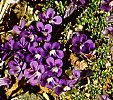
|
Buddleja (Buddleia, Sagewood genus) About 100 species
(Africa, Asia and America), with 10 species
native to southern Africa. A further seven species are cultivated as
garden plants in this region. Buddleja was previously placed in the
Buddlejaceae, which has now been synonymised with Scrophulariaceae. |
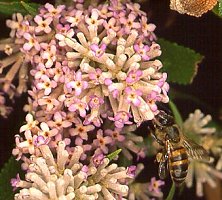
|
Camptoloma Three species, native to the
Canary Islands, Arabian Peninsula and Africa, with one species, Camptoloma
rotundifolium, native to southern Africa. |
|
Chaenostoma
Forty-four species native to southern Africa. |
|
Chamaecrypta One species, Chamaegigas
intrepidus, native to Namibia where it grows in ephemeral rock pools. |
|
Chamaegigas One species, Chamaegigas
intrepidus, native to Namibia where it grows in ephemeral rock pools. |
|
Chenopodiopsis The
three species are endemic to
the Northern Cape and Western Cape. |
|
Colpias One species, Colpias mollis,
endemic to the Northern Cape. Pollinated by oil-collecting bees (Rediviva). |
|
Craterostigma About nine
species, native to Arabian Peninsula, Socotra, India, Madagascar and
Africa. Five species occur in southern Africa. |
|
Cromidon Twelve species,
endemic to southern Africa (mainly Western and Northern Cape). |
|
Dermatobotrys One species,
Dermatobotrys saundersii, occurring in KwaZulu-Natal and Eastern
Cape, epiphytic on forest trees. |
|
Diascia Sixty-two species native to southern Africa. Many species are pollinated by oil-collecting
bees (Rediviva). |
|
Diclis About 10 species,
native to Africa and Madagascar, with about seven species in southern Africa. |
|
Dischisma Eleven species,
native to Namibia and coastal regions of Western and Eastern Cape. |
|
Freylinia Nine species,
all occurring in southern Africa. |
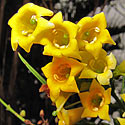 |
Glekia One species, Glekia
krebsiana, endemic to Lesotho and Eastern Cape. |
|
Globulariopsis The
seven
species are endemic to Western Cape. |
|
Glumicalyx Six species,
endemic to Lesotho and regions of South Africa bordering on Lesotho. |
|
Gomphostigma
Two species, native to Africa, with both species extending into southern
Africa. Previoiusly placed in the Buddlejaceae, which has been syonymised
with Scrophulariaceae. |
|
Gosela One species, Gosela
eckloniana, endemic to the Western Cape. |
|
Hebenstretia
All 24 species are native to southern Africa but a few have
distributions extending further north. |
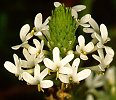
|
Hemimeris About
four species,
endemic to Northern, Western and Eastern Cape. |
|
Jamesbrittenia
Eighty-three species native to southern Africa. |
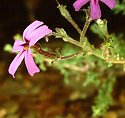 |
Lyperia Six species,
native to Namibia, Northern Cape and Western Cape. |
|
Manulea Of the 74 species,
73 are native to southern Africa and one to India. |
|
Manuleopsis One species, Manuleopsis
dinteri, endemic to Namibia. |
|
Melanospermum Six species,
endemic to southern Africa. |
|
Microdon Eight species,
endemic to Northern Cape and Western Cape. |
|
Nemesia About
65 species, native to Africa, with 64 species native to southern Africa,
mostly occurring in the Western Cape. |
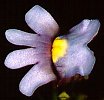
|
Oftia Three species,
endemic to southern Africa. |
|
Peliostomum About
five
species, native to Africa, mainly southern Africa. |
|
Phygelius Two species,
endemic to southern Africa. |
|
Phyllopodium A total of 26
species, endemic to southern Africa. |
|
Polycarena A total of 17
species, endemic to southern Africa. |
|
Pseudoselago A total of 27
species, endemic to southern Africa, mainly in the Western Cape. |
|
Reyemia Two species,
endemic to the Western Cape. |
|
Selago About 190 species,
native to Africa, of which 181 species occur in southern Africa. |
|
Stemodiopsis
Five species, native to Africa, three of which occur in
southern Africa. |
|
Strobilopsis One species, Strobilopsis
wrightii, native to Lesotho and KwaZulu-Natal. |
|
Sutera
Six species native to southern Africa. |
|
Teedia The
two species are
native to tropical and southern Africa, with both occurring in southern
Africa. |
|
Tetraselago Four species,
endemic to southern Africa. |
|
Trieenea
Ten species,
endemic to the Western and Eastern Cape. |
|
Zaluzianskya The 55
species are native to tropical and southern Africa, with 54 species in
southern Africa, mainly Western Cape. |
|
Genera naturalised in southern Africa
List from Smithies (2000).
Myoporum
Myoporum tenuifolium has become naturalised along the southern Cape
coast. An additional four species are cultivated in southern Africa.
Myoporum was previously placed in the Myoporaceae, which is now
synonymised with Scrophulariaceae. |
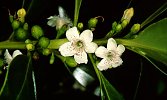 |
Verbascum [=
Celsia] About 360
species, native mainly to the northern temperate regions of the Old World.
Verbascum blattaria and Verbascum virgatum are garden
escapes in southern Africa. In addition, there are five other exotic species
(including two previously placed in Celsia) cultivated in southern Africa. |
|
Other genera, cultivated in southern Africa
List from Glen (2002). The species name is provided in
genera that have only one species cultivated in southern Africa. Many genera in Glen's list of
Scrophulariaceae are now in other families in the
Lamiales.
Bontia daphnoides
Native to the Caribbean. Previously Bontia was placed in the
Myoporaceae, which is now synonymised with Scrophulariaceae. |
|
Eremophila debilis
Native to eastern Australia and New Zealand. Previously Eremophila
was placed in the Myoporaceae, which is now synonymised with
Scrophulariaceae. |
|
Scrophularia
Three species cultivated. |
|
Publications
-
Glen, H.F. 2002. Cultivated Plants of
Southern Africa. Jacana, Johannesburg.
-
Smithies, S.J. 2000. Scrophulariaceae. In: Seed Plants of
Southern Africa (ed. O.A. Leistner). Strelitzia 10: 508-537.
National Botanical Institute, Pretoria.
-
Victor, J.E. 2000. Buddlejaceae. In: Seed Plants of
Southern Africa (ed. O.A. Leistner). Strelitzia 10: 195-196.
National Botanical Institute, Pretoria.
-
Welman, W.G. 2000. Myoporaceae. In: Seed Plants of
Southern Africa (ed. O.A. Leistner). Strelitzia 10: 417.
National Botanical Institute, Pretoria.
-
Welman, W.G. 2003. Myoporaceae. In
Germishuizen, G. & Meyer, N.L. (eds), Plants of southern Africa: an
annotated checklist. Strelitzia 14: 745. National Botanical
Institute, Pretoria.
|
